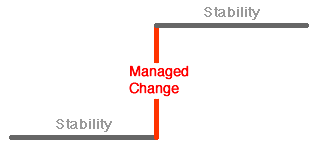
It made me rise the question:
Is Change Management – as we know it –
still the best way to „drive change“?
In my concept, I combined a new approach on organizational change management with the possibilities of socialbusiness and the lessons learned of culture development in a global environment
Why sharing this? Because we all can make a difference by sharing (and questioning) our experience – and find like-minded people to exchange!
Learning from each other
is a great way to improve.
Reading great books from authors like John P. Kotter, Peter Senge, William Bridges or theories of Elisabeth Kübler-Ross, the famous MBTI (Myers & Briggs) and many other valuable sources for most common approach on Change Management – I see a focus on:
- „Management“ (as initiators and drivers),
- „Involvement“ (as a success criteria) and
- „Control“ (to ensure sustainability)
It looks great in theory (I am coming from the practical perspective) – when we see the simplified stages of a change process: „Stability“ – „managed change“ – „Stability“ …I would already question this to a certain extend.

Yes we all (most people) love stability, making our life’s easier to predict and plan as well as giving security.
But looking at all those massive, simultanious changes all around us – combined with it’s speed and impact to more and more people, I find it a better approach to call it „permanent beta“ or „work in progress“, „draft mode“, or in private life… „we are on a way“
… or isn’t a „stable final“ just a compromise
to make us feel good, or to report fulfillment?

Differences in todays „Change Management“
(some authors already re-named it to „leading change“)
| Change Management as known | Leading Change (as desired in my eyes) | |
| Organization form: | made for hierarchical, disciplinary driven Top-Down Organizations (networking or transparency did not really exist) | hierarchical + network organizations, agile Scrum-Teams, dynamic and responsive Interest groups, Entrepreneurs (also within companies) |
| Target group / actors: | Management | All |
| Main attributes: | Managing, Steering, control | listen respect, engage, participate, learn, do, share |
| Scope of tools & methods: | less than 20 persons (small groups), except surveys (which I do not consider real involvement) | today we can reach and involve huge amounts of people (via direct, transparent communication & collaboration Social Media/Social Business) – also with new formats like fishbowl, information market, future conference, fedex-days, open spaces, hangouts, MOOCs |
Hierarchy versus Network:
After learning about all those theories of Change Management – I was missing this, in my eyes important movement of collaborative networks, transparency and respect in people – most of all the acknowledgement of our various perspective and cultures. It made me very happy to find Mr John Kotter to come up with his update „accelerate“ (Harvard Business Review) of adding „networking“ as a second „operating system“ to his concept…
You can imagine, that I really like this valuable update coming from one of the most experienced and influential Change Experts worldwide.
I might be excused to have a small critic here – in my eyes only his picture of two Operating Systems is not ideal. (again coming from the practical use) Operating Systems mostly only „co-exist“ (we really see this problem in many companies today – but that is not the goal – as Kotter mentions – it is about allowing and highly integrating both: As written 2 years ago: Hierarchy and Networks). My picture would be more hierarchy as operating system and networks as „Apps“: connected, topic or interest driven, time and goal relevant… mash-ups, sparks, need- and goal driven collaborations.
Management fears loosing power by highly connected influencers and transparency, Networks are missing the „OK we want and need you“ from leaders and being recognized, asked and appreciated. This is causing a lot of energy being lost, since networks still need to „prove their benefit“… Besides we are not seeing only one network, but many of them – very different, in all means – makes it hard to classify or putting a „profit-tag“ on them.
Not only in big companies we still need hierarchy (vertical) AND networks (horizontal)… for quite some time (Hierarchy provides a reliable decision processes, continuity and security)
… this is only a small fraction of an article I am writing on for a while – more coming up 😉
- Part II: Change – Values – One Size fits All
Still I would love to hear from you and get your opinion – do you experience something similar, do you have thoughts to add or questions we could include?
just add your comment, please! (that would encourage me to write more sooner 😉
Update: Feedback from other sources:
- Xing / Björn Schotte: Link recommendations:

Schreibe einen Kommentar